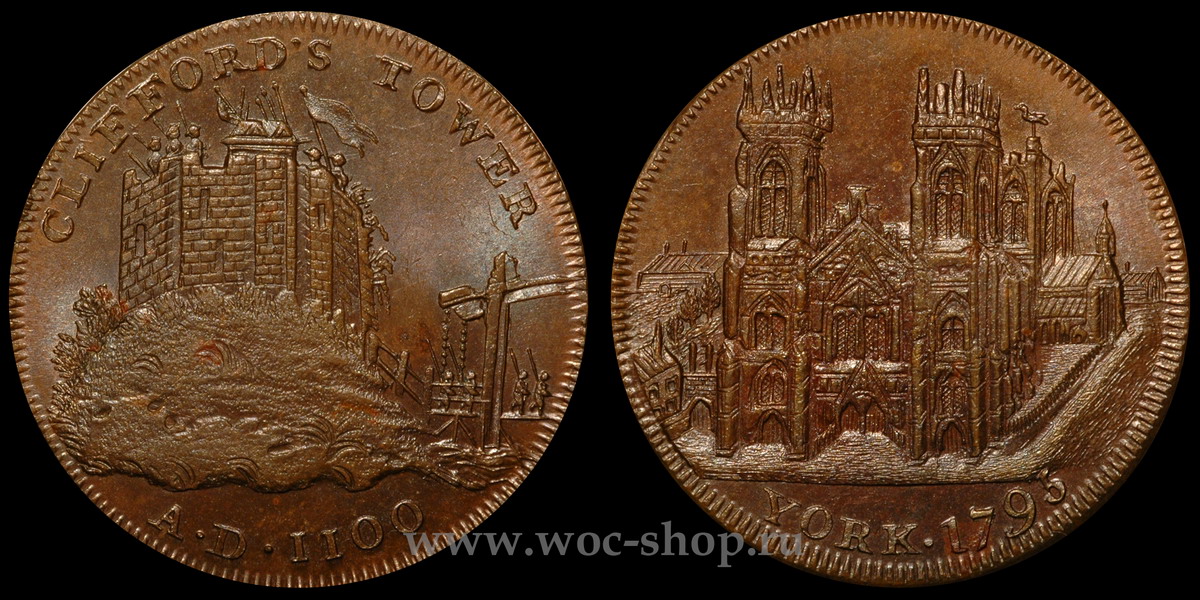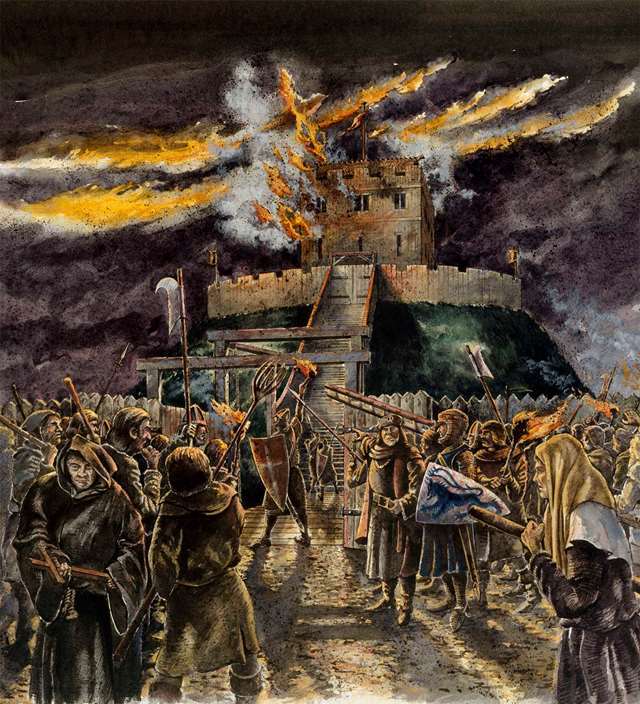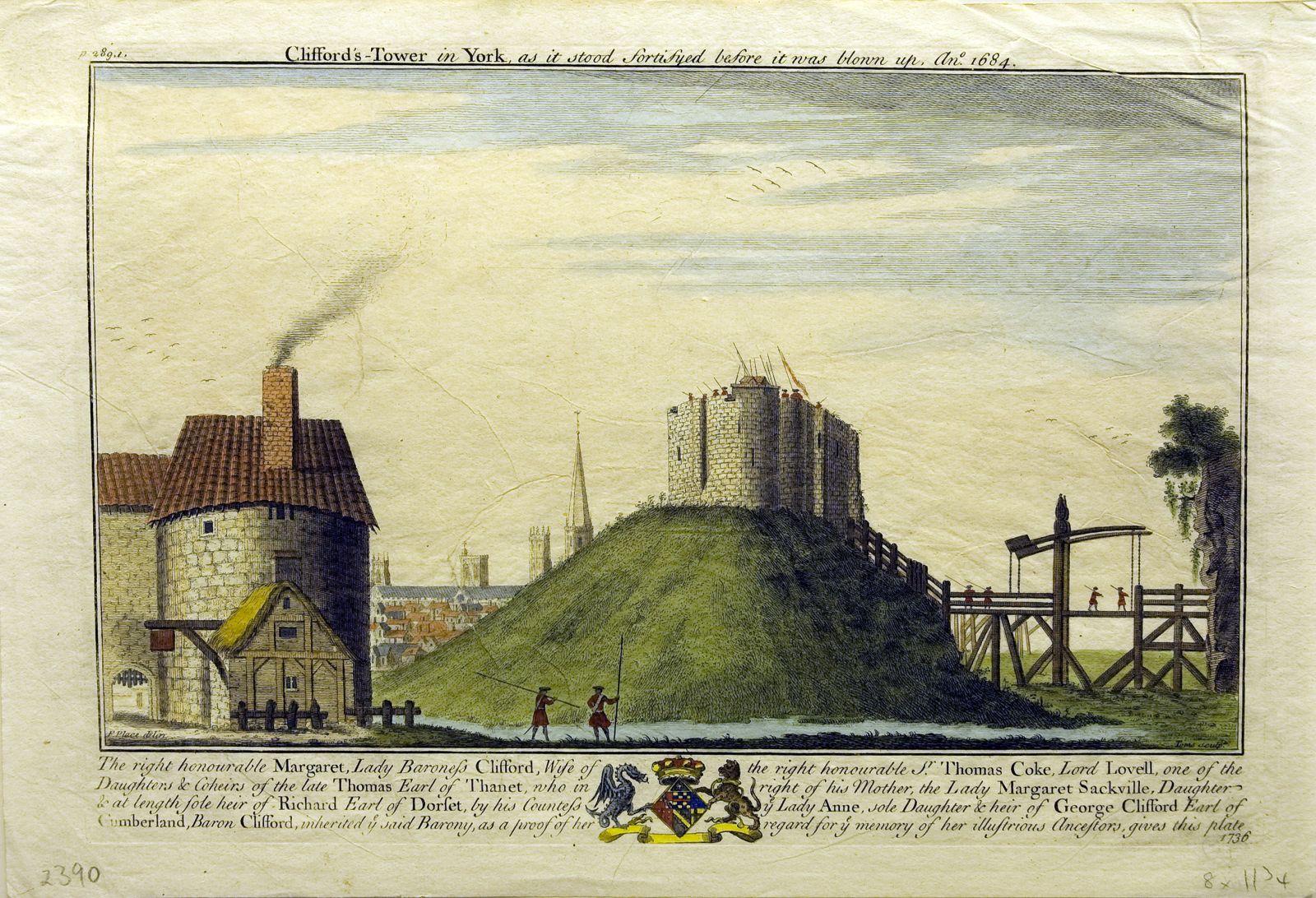
Online collections
monedastodas.com
All collections » Tokens » York Halfpenny
The front side depicts York Minster.
The reverse side depicts a fortress on a
mound, guarded by armed men. Four warriors armed with pikes are
walking along the drawbridge.
The customer for the production of the token is not exactly known, but in 1796 Harrison and Cattle issued a 2 ¾ inch diameter medal of a similar design and may also have been responsible for this issue.

In 625, Archbishop Paulinus erected a
small wooden chapel in York in honor of St. Peter. On April 12,
627, the baptism of King Edwin (c. 585 - 633) with his family and retinue took
place in this chapel. The construction of the current cruciform
building of the cathedral on the site of the old chapel lasted about 250 years
and was completed in 1472. It is 524 feet long and 250 feet wide. The
west front is flanked by two towers 196 feet high, while the central or lantern
tower rises to 235 feet.
The cathedral is famous for having the
largest stained-glass windows of medieval Europe and contests the title of the
largest medieval temple in the north of Europe from Cologne Cathedral.
Clifford Tower is located on an
artificial mound, which, according to archaeological evidence, was built in
Roman times.
In 1068, William the Conqueror went to
the north of the country to crush the uprising. He built a number
of wooden fortresses, including where Clifford's tower now stands.
During the 12th century, tensions between
Christians and Jews escalated throughout England, partly because many were
indebted to Jewish usurers, partly due to Christian propaganda. Following
the coronation of Richard I in 1189, anti-Jewish riots took place in several
cities. According to accounts, about 150 people from the Jewish
community of York took refuge in the fortress. The troops trying to
recapture the captured fortress were joined by a large crowd of people, incited
by anti-Jewish preachers and local nobles seeking to avoid paying debts. On
March 16, the Saturday before Passover, the captives inside the tower realized
that they could not get out safely and the rabbi called for mass suicide. The
heads of households killed their families before killing themselves, and the
wooden fortress itself was set on fire.
 Reconstruction
of the events of 1190, when the Jewish community of York was besieged and
attacked by an angry mob. Historic England (illustrated by Peter
Dunn)
Reconstruction
of the events of 1190, when the Jewish community of York was besieged and
attacked by an angry mob. Historic England (illustrated by Peter
Dunn)The fortress burnt
down in 1190 was soon restored. In 1245, King Henry III decided to
build a new round tower on the mound. The order to Master Henry the
Mason and Master Simon the Carpenter spoke of the need to strengthen the
defenses and build a stone tower and castle, which continued until the 1290s.
During the 15th-16th centuries, some
buildings of the castle were destroyed, while others were used as a prison. For
the first time, the name Clifford's Tower is found in 1596 in documents about
the accusation of the jailer Robert the Red in an attempt to sell the stone of
abandoned buildings. According to one version, this name could come
from the statements of the Clifford family that the position of constable was
hereditary. According to another version, the name may refer to the
rebel Roger de Clifford, who was hanged in the tower after the Battle of
Boroughbridge in 1322.
In 1643, during the Civil War, to protect
the city, the tower was equipped with two half-culverins and a sacker and
attached the royal garrison Threescore foot. The turret building
was extensively refurbished, with an ammunition depot and a platform with guns
on the roof built. In 1665, on the way to Scarborough Castle, the
Quaker George Fox was imprisoned in the tower for two nights.
 Engraving
of Clifford's tower in 1680 before it exploded in 1684
Engraving
of Clifford's tower in 1680 before it exploded in 1684The dissolute
behavior of the garrison angered the people of York, who called for the
demolition of the tower, nicknamed The Minced Pie (stuffed pie). On
the night of April 23, 1684, the inside of the tower was partially destroyed by
the explosion of a gunpowder store that occurred after the fireworks in honor of
St. George's Day. In the 18th century, the tower was located on the
territory of a private garden and could be used as a cattle shed, while the
former castle building was used as a prison.
In the 20th century, detailed
archaeological research and strengthening of the mound were carried out, the
outer walls were restored, a staircase was built and a museum is currently open
in the tower.
Edge inscription: YORK BUILT AM1223. CATHEDRAL
REBUILT AD 1075 + Engraver Dixon, made by Lutwyche.
Issued 5 cwts (1 cwts = 100 lb =
45.359237 kg).